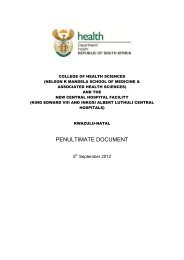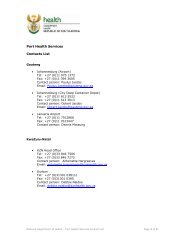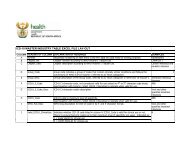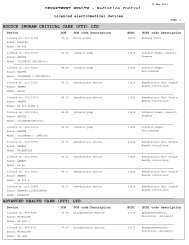Any genera<strong>to</strong>r of waste is responsible <strong>to</strong> ensure that waste is h<strong>and</strong>led, s<strong>to</strong>red, collected disposed <strong>and</strong>transported in an environmentally sound manner.• Polluter pays principleAny person causing pollution is responsible for any costs incurred in the cleaning <strong>and</strong> rehabilitation of theimpacts on the environment.• Precautionary principleIt is the responsibility of the waste genera<strong>to</strong>r <strong>to</strong> ensure that waste is less hazardous before it is disposedoff.• Proximity principleThe treatment <strong>and</strong> disposal of hazardous waste should take place as near as possible <strong>to</strong> the point ofproduction, in order <strong>to</strong> minimize transportation <strong>and</strong> environmental risks.• Cradle <strong>to</strong> Grave principleAny genera<strong>to</strong>r of health care risk waste is legally responsible for its final disposal from point of generation<strong>to</strong> final disposal.STANDARDSSECTION 1: WASTE MINIMIZATIONWaste minimization refers <strong>to</strong> activities that involves the reuse, reduce, recovery <strong>and</strong> recycling of waste.Recovery means the process of converting waste in<strong>to</strong> other resources such as electricity, heat, compos<strong>to</strong>r fuel, through thermal <strong>and</strong> biological means. Resource recovery occurs after reduce, reuse <strong>and</strong> recyclehave been attempted. To recycle means <strong>to</strong> use, re use or reclamation waste. To reduce means <strong>to</strong> limitthe amount of waste generated, <strong>and</strong> <strong>to</strong> reuse means <strong>to</strong> use materials or items that one would normallydispose of, again.1. Responsibilities of waste genera<strong>to</strong>rs with regards <strong>to</strong> reduce, reuse, recycle <strong>and</strong> recovery ofwaste:a) In terms of the NEMA Waste Act 59 of 2008, the waste genera<strong>to</strong>r must:• Take practicable measures <strong>to</strong> avoid the production of waste <strong>and</strong> <strong>to</strong> reduce it or reduce its <strong>to</strong>xicity,recycle <strong>and</strong> recover waste, where possible;• Separate waste with the aim of minimizing waste <strong>and</strong> its impacts on the environment; <strong>and</strong>• Consider the use of less natural resources than disposal <strong>and</strong> protection <strong>to</strong> the environment beforeany reduce, reuse, recycle <strong>and</strong> recovery of waste activity takes place.b) Recycled wastes from residential, business, Industrial premises <strong>and</strong> kerb side collection must bes<strong>to</strong>red in suitable, intact, corrosive resistant <strong>and</strong> leak proof containers or bags.c) Recycled waste shall be collected within reasonable time <strong>to</strong> prevent a nuisance <strong>to</strong> be created.EHPs should moni<strong>to</strong>r waste minimization activities on premises during inspections <strong>and</strong> educate <strong>and</strong>encourage businesses <strong>and</strong> the community on:• The type of waste <strong>to</strong> minimize;,• How minimize waste;• Where <strong>and</strong> how <strong>to</strong> s<strong>to</strong>re recycled waste;• Recycling companies <strong>to</strong> be contacted when starting a recycling project.2. Waste Recycling at business premises <strong>and</strong> industrial premises <strong>and</strong> Buy-Back centers orDrop Off CentersEH should moni<strong>to</strong>r that the premises used for waste recycling at business, industrial premises, <strong>and</strong> buyback or drop off centers conform <strong>to</strong> the following st<strong>and</strong>ards:DOH. <strong>Norms</strong> <strong>and</strong> st<strong>and</strong>ards for environmental health in South Africa Feb 2013 116
a) The premises used for recycling shall be located, designed, constructed in accordance with approvedbuilding plans <strong>and</strong> in such a manner that a public health hazard will not occur.b) The premises must have an approved fire protection plan in terms of the <strong>National</strong> BuildingRegulations <strong>and</strong> <strong>National</strong> Building St<strong>and</strong>ards Act, 1977, <strong>to</strong> show fire protection measures.c) The premises must be provided with adequate ventilation <strong>and</strong> lighting as prescribed in the <strong>National</strong>Building Regulations <strong>and</strong> <strong>National</strong> Building St<strong>and</strong>ards Act, 1977.d) The floors of the premises must be constructed of cement concrete or similar impervious material.The floors must be adequately graded <strong>and</strong> drained for the disposal of effluent <strong>to</strong> an approveddisposal system.e) The inside walls must be smooth <strong>and</strong> painted with a light coloured washable paint, except whereglazing, glass bricks or glazed tiles are used.f) The surface of the open space on the yard of the premises shall be paved with paving bricks or withconcrete or similar impervious material brought <strong>to</strong> a smooth finish.g) Adequate supply of portable water shall be provided.h) Adequate sanitary fixtures for use by workers <strong>and</strong> patrons shall be provided as prescribed in the<strong>National</strong> Building Regulations <strong>and</strong> <strong>National</strong> Building St<strong>and</strong>ards Act, 1977.i) The perimeter wall around the premises shall be made of bricks, concrete or steel palisade, or otherdurable material, with a minimum height of 2 meters.j) The gates <strong>to</strong> the premises shall be of solid construction with a minimum height of 2 meters.SECTION 2: OBLIGATIONS FOR GENERAL AND HAZARDOUS WASTE HANDLINGEHPs should moni<strong>to</strong>r <strong>to</strong> ensure that the below obligations with regard <strong>to</strong> general <strong>and</strong> hazardous wasteh<strong>and</strong>ling are adhered <strong>to</strong>:a) Waste genera<strong>to</strong>rs are responsible for their waste from point of generation <strong>to</strong> final disposal;b) The generation, recycling, s<strong>to</strong>rage, collection, treatment, transportation <strong>and</strong> disposal of waste shall bemanaged so as not <strong>to</strong> endanger the health of the public or the environment or become a nuisance;c) All waste genera<strong>to</strong>rs shall ensure that they have adequate, approved s<strong>to</strong>rage waste receptacles orcontainers.d) All waste genera<strong>to</strong>rs of the following classes of waste must have Waste Management Plans in place,such plans must be submitted <strong>to</strong> the local authority environmental health department for evaluation,moni<strong>to</strong>ring implementation, approval <strong>and</strong> record keeping <strong>to</strong> ensure that waste is managed in a soundmanner <strong>to</strong> protect the health of the public.• Business waste;• Industrial waste;• Building waste;• Event waste;• Hazardous waste.e) The Waste Management Plan shall include-:• an assessment of the quantity of waste that will be generated;• type or characteristic of waste that will be generated;• a description of the services provided <strong>to</strong> s<strong>to</strong>re, collect, transport <strong>and</strong> dispose of such waste;• a contract with the service provider for collection <strong>and</strong> final disposal <strong>to</strong> the licensed waste disposalfacility; <strong>and</strong>• a description on the separation of recyclable <strong>and</strong> non-recyclable waste at the point of source;• the waste minimization measures through reduction, reuse, reuse <strong>and</strong> recovery• pollution prevention measures; the impact or potential impact on the environment <strong>and</strong> the healthof the public <strong>and</strong> any workers, that can be created by the waste generated;• remedial measures that are <strong>to</strong> be implemented on the impacts identified; <strong>and</strong>• Any additional information that the local council or municipality may require.f) All genera<strong>to</strong>rs of hazardous waste shall have a safety data sheet as prescribed in SANS 10234;g) All waste management activities (s<strong>to</strong>rage, reuse, recovery, recycling, treatment <strong>and</strong> disposal ofgeneral <strong>and</strong> hazardous waste) as listed in the attached schedule (Appendix A), must apply forenvironmental authorization in terms of the NEMA: <strong>Environmental</strong> Impact Assessment (EIA)Regulations 543 of 2010.DOH. <strong>Norms</strong> <strong>and</strong> st<strong>and</strong>ards for environmental health in South Africa Feb 2013 117
- Page 1 and 2:
No. 36849 GOVERNMENT GAZETTE, 20 SE
- Page 3 and 4:
AcknowledgementsDrafting Team (Nati
- Page 5 and 6:
Preamble by Director-GeneralThe Nat
- Page 7 and 8:
POLICY AND LEGISLATIVE FRAMEWORKThe
- Page 9 and 10:
1. Introduction1.1 Policy contextOn
- Page 11 and 12:
5. Monitoring and enforcing complia
- Page 13 and 14:
BACKGROUNDHealth surveillance of pr
- Page 15 and 16:
h) Adequate and potable water avail
- Page 17 and 18:
a) Entrance and exit control must b
- Page 19 and 20:
• Storage of unsafe, toxic, dange
- Page 21 and 22:
(i) For children between 0-24 month
- Page 23 and 24:
• The health certificate holder,
- Page 25 and 26:
a) Separate storage facilities must
- Page 27 and 28:
2.4 Inspections should include an a
- Page 29 and 30:
g) Adequate facilities must be prov
- Page 31 and 32:
d) Corridors must be at least 1.8m
- Page 33 and 34:
1. NORMS1.1 Schools to be operated
- Page 35 and 36:
• A cardiopulmonary mouthpiece pr
- Page 37 and 38:
a) All circumcisions must be conduc
- Page 39 and 40:
) Toilets, wash hand basins and bat
- Page 41 and 42:
• Liquid soap;• First aid instr
- Page 43 and 44:
h) A daily record must be kept on t
- Page 45 and 46:
t) A separate room or area with sep
- Page 47 and 48:
h) An adequate number of purpose-ma
- Page 49 and 50:
c) Health care facilities should ha
- Page 51 and 52:
a) All facilities used in connectio
- Page 53 and 54:
5. General hygiene requirementsa) T
- Page 55 and 56:
1.1 The premises operated under a v
- Page 57 and 58:
5. Environmental health should cond
- Page 59 and 60:
d) The use of non-waterborne sanita
- Page 61 and 62:
so many kgs of manure is produced p
- Page 63 and 64:
a) On any residential premises, onl
- Page 65 and 66: n) A rodent-proof storeroom must be
- Page 67 and 68: d) Pets must be vaccinated against
- Page 69 and 70: 1.3 The premises in compliance with
- Page 71 and 72: 2.1 Environmental health inspection
- Page 73 and 74: 2.1 Environmental health inspection
- Page 75 and 76: 1) Responsibility of management1.1.
- Page 77 and 78: that all possible health impacts of
- Page 79 and 80: BACKGROUNDThe Scope of Profession o
- Page 81 and 82: a) An Integrated Disease Surveillan
- Page 83 and 84: a) All food onboard must be stored
- Page 85 and 86: 3. Waste managementa) The managemen
- Page 87 and 88: c) Documents outlining prevention,
- Page 89 and 90: Chapter 3HEALTH RELATED WATER QUALI
- Page 91 and 92: d) The catchment (rivers, treatment
- Page 93 and 94: f) Ensuring monitoring of effective
- Page 95 and 96: SECTION 4:WATER QUALITY MONITORING
- Page 97 and 98: water world etc)1. In the event of
- Page 99 and 100: Step 2: if water is obtained from t
- Page 101 and 102: • Of the time frame, if any, with
- Page 103 and 104: 3. Household grey-water (generated
- Page 105 and 106: SECTION 14:MONITORING OF DRINKING W
- Page 107 and 108: contamination (e.g. from birds and
- Page 109 and 110: SECTION 21: COMPLIANCE ENFORCEMENT6
- Page 111 and 112: DEFINITION OF APPLICABLE TERMSThe f
- Page 113 and 114: BACKGROUNDWaste management is the c
- Page 115: • Provides municipal health servi
- Page 119 and 120: SECTION 4: COLLECTION OF GENERAL WA
- Page 121 and 122: SECTION 7: CLASSIFICATION, PACKAGIN
- Page 123 and 124: • The spillage area shall be mark
- Page 125 and 126: • Elbow length heavy duty gloves,
- Page 127 and 128: anatomical waste anatomical • Hav
- Page 129 and 130: • Waste oxidizing substances and
- Page 131 and 132: Sharps container 90 days Cool room
- Page 133 and 134: Relationships between transboundary
- Page 135 and 136: Chapter 5HAZARDOUS SUBSTANCES AND C
- Page 137 and 138: 3. The premises used in connection
- Page 139 and 140: d) In addition, all hazardous subst
- Page 141 and 142: 4. Guidelines for Drinking Water Qu
- Page 143 and 144: for conducting monitoring.7. Analyz
- Page 145 and 146: Bacterial infectionsCholeraCampylob
- Page 147: paralytic aspeticmeningitis. The re


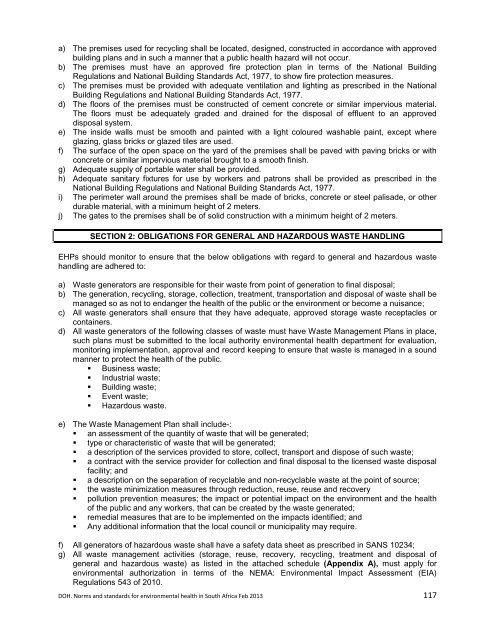



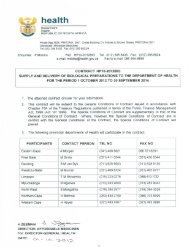
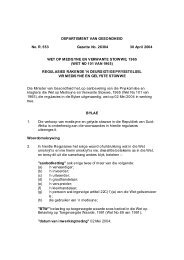
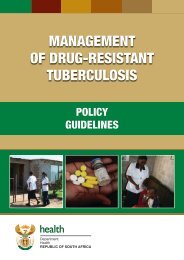
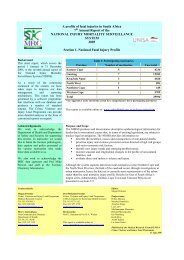
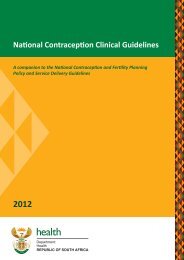
![A monograph of the management of postpartum haemorrhage [2011]](https://img.yumpu.com/15578784/1/184x260/a-monograph-of-the-management-of-postpartum-haemorrhage-2011.jpg?quality=85)
